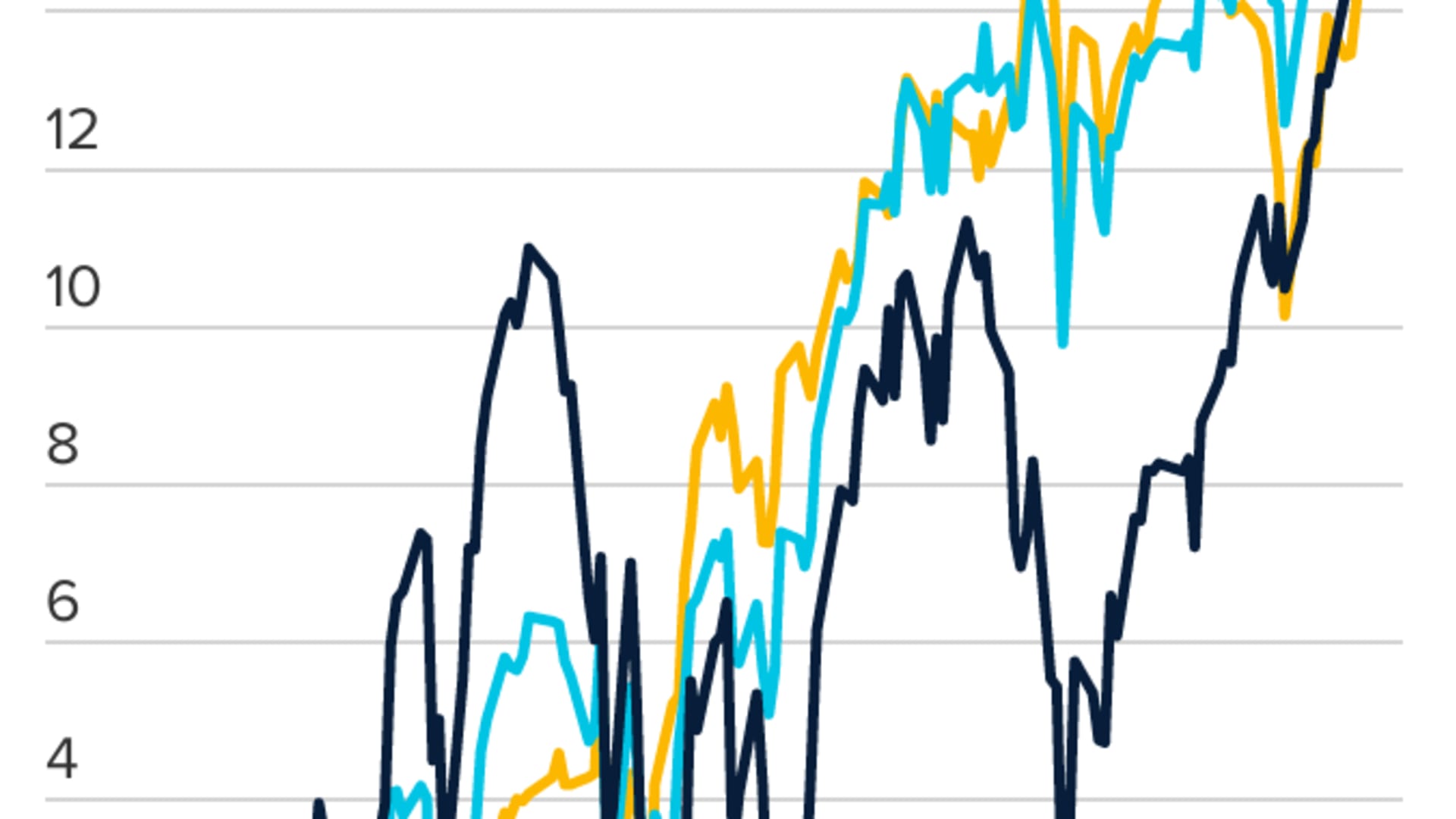- The Fourth of July holiday week looks like a sleeper for stocks, with little data and quiet pre-earnings season trading.
- But the Fed releases the minutes from its last meeting where it revealed it was starting to talk about cutting back on its bond buying. If there are more details, it could move markets.
- Stocks gained in the past week, and the S&P 500 and Nasdaq hit new record highs after Friday's employment report showed 850,000 payrolls were added in June.
The quiet holiday week ahead could hold some fireworks for investors if the Federal Reserve reveals its thinking on its bond buying program.
The four-day trading week could see stocks drift, after hitting new highs this past week. The closely watched 10-year Treasury yield has held under 1.5%, a positive for tech which outperformed with a 3.2% gain for the week.
There are very few economic reports of note, aside from ISM services data on Tuesday. But the Fed's minutes from its last meeting will be released Wednesday afternoon, and there is potential for the market to learn more about the central bank's behind-the-scenes discussions on winding down its quantitative easing program.
Get Boston local news, weather forecasts, lifestyle and entertainment stories to your inbox. Sign up for NBC Boston’s newsletters.
"Our base case is that rates drift higher, but in order to that get that move higher you need a catalyst to get there," said Brian Daingerfield, head of G10 FX strategy Americas at NatWest Markets. "Either the Fed has to move forward aggressively on tapering, or you have to get the data really rocking, and you don't have either."
Friday's report that 850,000 jobs were added in June was better than expected. However, the unemployment rate missed expectations after rising by 0.1 percentage points to 5.9%. Economists expected the rate to fall to 5.6%. The report was not seen as strong enough to encourage the Fed to step away sooner from its easy policies. It was, however, seen as a positive — yet largely incomplete — picture of the labor market.
Daingerfield said there is the potential for the Fed's June meeting minutes to surprise the market, similar to the way April minutes did.
Money Report
"Remember, Powell said they were not talking about talking about tapering," he said, referring to Fed Chairman Jerome Powell's comments right after the April meeting. "Remember, Powell was very dismissive, and then the minutes revealed a kind of drift to the committee."
The April meeting minutes did surprise investors when they noted that "a number of participants" said it would be appropriate to begin discussing tapering bond purchases at upcoming meetings if the economy continues to make rapid progress. After the June meeting, Powell revealed early stage discussions about paring back bond buying. The Fed also presented a new forecast that included two rate hikes in 2023, where there were none indicated before.
The market is highly sensitive to details about the Fed's bond purchase program since the ending to that measure would be open the door for the central bank to raise interest rates. The low-rate environment has been the kindling behind the stock market's robust gains since the Fed went all out to help the economy get through the pandemic. Cutting back on the monthly $120 billion bond purchases would be the first rollback of those extraordinary measures.

"There's a lot we don't know about the Fed's thinking about tapering," Daingerfield said. He said key information would be when it plans to start, how rapidly it will move to wind down the program and how it decides to break down its current monthly purchases of $80 billion in Treasurys and $40 billion in mortgage securities.
"These details really do matter. Did they get into that conversation at all about details? The more detail they discussed, the more likely it is they are looking to move forward sooner," Daingerfield said. Fed watchers widely expect more details about tapering the bond program around its annual symposium in Jackson Hole, Wyoming in late August, and then start slowing purchases later this year or early in 2022.
For now, the positive tone in the bond market has helped stocks. The 10-year yield, which moves opposite price, has fallen from its high of the year of about 1.75%. At that level, technology and growth shares were under pressure.

But they've been making a comeback as rates drift around in a range below 1.6%. The 10-year was at 1.43% Friday, and while the lower rate may help tech stocks, the yield level is a sharp contrast to an economy that was expected to grow at more than 10% in the second quarter.
That pace is expected to slow, but growth for the year is expected to be robust at more than 7%.
Tech transition
Citi Private Bank chief investment strategist Steven Wieting said that, with the economy peaking, the time is right for investors to begin transitioning to tech and growth shares from the popular cyclical trade.
"We're seeing this as all a temporary period of massive distortions, and within a year from now, we'll be on steadier water," he said. "I think this is giving people a reason, including us, to move away from just cyclical rebound trades and into some sustainable growth opportunities."
Year to date, cyclicals have been some of the better performers. Energy shares are up 44.5% with the rebound in oil prices, and financials have bounced 25.2%. In contrast, S&P 500 growth stocks are up 14.3%, lagging slightly the S&P 500's 15.5% gain. Tech stocks are up just 14.9% year-to-date.
One area Wieting now likes is global health care. The S&P 500 health care sector was up 12.5% for the year so far.
"Health care is a mid-cycle outperformer. Health care is a part of the economy that didn't fall as hard," he said. "Earnings and revenues have grown moderately every year since the mid-1980s." He said the sector has lagged the S&P 500 since the end of 2019 by 10 percentage points, and has a cheap valuation. Big pharma stocks are among the best dividend payers.
For the major sectors, on a 12-month basis, the cyclical sectors of industrials, materials, and energy have all risen more than 40%, and tech has had a similar 42% gain.
"The growth stocks have stayed rich. The value stocks have completely caught up with growth stocks in 12-month performance, but the valuation hasn't been beaten down in growth stocks," he said. "Gradually we're going to get more sustained performance out of tech after this period where it flatlined."
Wieting said one area that is particularly attractive is cybersecurity, where demand is strong as a "tech spending essential," but the sector has gone nowhere.
For instance, the iShares Cybersecurity and Tech ETF IHAK is just below its 52 week high set in January, and the Global X Cybersecurity ETF BUG is trading about a dollar below its February high.
Wieting said he likes some alternative energy names and companies that are involved in digitization, including fintech.
He expects the overall stock market to move higher but not at the same rapid clip.
"We want to start transitioning portfolios away from just rebound plays...We're transitioning, knowing we've captured significant outperformance over the past year with cyclical value. It made people comfortable investing in equities when we could show how cheap they were," he said.
The S&P 500 ended the week up 1.7% at a record 4,352, while the Dow climbed 1% to 34,786. The Nasdaq was 1.9% higher, ending the week at a record 14,639.
Week ahead calendar
Monday
Independence Day holiday observed
Tuesday
9:45 a.m. Services PMI
10:00 a.m. ISM Services
Wednesday
10:00 a.m. JOLTS
2:00 p.m. FOMC minutes
3:30 p.m. Atlanta Fed President Raphael Bostic at National Association of Black Journalists event
Thursday
8:30 a.m. Jobless claims
3:00 p.m. Consumer credit
Friday
10:00 a.m. Wholesale trade






